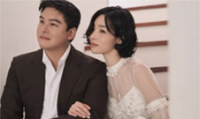▶ I. M. PEI
“Contemporary architects tend to impose modernity on something. … A lasting architecture has to have roots.”
DOHA, Qatar - I can’t seem to get the Museum of Islamic Art out of my mind. There’s nothing revolutionary about the building. But its clean, chiseled forms have a tranquillity that distinguishes it in an age that often seems trapped somewhere between gimmickry and a cloying nostalgia.
Part of the allure may have to do with I.M.Pei, the museum’s architect. Mr.Pei reached the height of his popularity decades ago with projects like the East Building of the National Gallery of Art in Washington and the Louvre pyramid in Paris. Since then he has been an enigmatic figure. His best work has admirers, but it has largely been ignored within architecture’s intellectual circles. Now, at 91 and near the end of a long career, Mr.Pei seems to be enjoying a revival.
The museum is also notable for its place within a broader effort to reshape the region’s cultural identity. The myriad largescale civic projects, from a Guggenheim museum planned for Abu Dhabi to Education City in Doha, are often dismissed in Western circles as superficial fantasies.
As the first to reach completion, the Museum of Islamic Art is proof that the boom is not a mirage. The building’s austere, almost primitive forms and the dazzling collections it houses underscore the seriousness of the country’s cultural ambition.
Perhaps even more compelling, the design is rooted in an optimistic worldview - one at odds with the schism between cosmopolitan modernity and backward fundamentalism that has come to define the last few decades in the Middle East. It embodies the ideal that the past and the present can co-exist harmoniously.
To Mr.Pei, all serious architecture is found somewhere between the extremes of an overly sentimental view of the past and a form of historical amnesia.
“Contemporary architects tend to impose modernity on something,”he said in an interview.“There is a certain concern for history but it’s not very deep. I understand that time has changed, we have evolved. But I don’t want to forget the beginning. A lasting architecture has to have roots.”
His work has never lost its aura of measured idealism. It reached its highest expression in the National Gallery of Art’s East Building, a composition of angular stone forms completed in 1978 that is the most visible emblem of modern Washington.
Since that popular triumph, Mr.Pei has often seemed to take the kind of leisurely approach to design that other architects, no matter how well established, can only dream of. When first approached in 1983 to take part in a competition to design the addition to the Louvre, he refused. President Francois Mitterrand nevertheless hired him. Mr.Pei then asked him if he could take several months to study French history.
He spent months traveling across Europe and North Africa before beginning work on the final design of the glass pyramids.
Such an attitude runs counter to the everaccelerating pace of the global age - not to mention our obsession with novelty. Mr.Pei, by contrast, imagines history as a smooth continuous process - a view that is deftly embodied by the Islamic Museum, whose clean abstract surfaces are an echo of both high Modernism and ancient Islamic architecture. Mr.Pei’s aim was to integrate the values of that earlier era into today’s culture - to capture, as he put it, the“essence of Islamic architecture.”
Mr.Pei located his museum on a small man-made island, approachable from a short bridge. The bridge, flanked by rows of tall palm trees, is set diagonally to the entry, which makes the stacked geometric forms appear more angular and the contrast between light and shadow more extreme.
His museum reminds us that building a culture, as much as a political or social agenda, can be an act of healing. Like all great art, it requires forging seemingly conflicting values into a common whole.
스마터리빙
more [ 건강]
[ 건강]이제 혈관 건강도 챙기자!
[현대해운]우리 눈에 보이지 않기 때문에 혈관 건강을 챙기는 것은 결코 쉽지 않은데요. 여러분은 혈관 건강을 유지하기 위해 어떤 노력을 하시나요?
 [ 건강]
[ 건강]내 몸이 건강해지는 과일궁합
 [ 라이프]
[ 라이프]벌레야 물럿거라! 천연 해충제 만들기
 [ 건강]
[ 건강]혈압 낮추는데 좋은 식품
[현대해운]혈관 건강은 주로 노화가 진행되면서 지켜야 할 문제라고 인식되어 왔습니다. 최근 생활 패턴과 식생활의 변화로 혈관의 노화 진행이 빨라지고
사람·사람들
more
김응화 단장, 아쿠아리움 퍼시픽 ‘헤리티지 어워드’
김응화무용단의 김응화 단장이 롱비치의 아쿠아리움 오브 더 퍼시픽이 수여하는 2025년 ‘헤리티지 어워드’의 영예를 안았다. 올해 처음 개최된 …

이정임 무용원, 팬아시아 전통예술 경연대회
남가주 최대 규모의 아시아 전통 예술 경연대회인 팬아시아 댄스 앤 드럼 대회에서 이정임무용원의 청소년 단원들이 경연에 참가해서 전체 대상 등 …
유희자 국악무용연구소, 팬아시아 전통예술대회
지난 15일 샌개브리얼 셰라톤 호텔에서 열린 남가주 최대 규모의 전통 무용대회인 팬아시아 댄스 앤 드럼 대회에서 유희자 국악무용연구소(원장 유…
송년행사 안내해드립니다
다사다난했던 2025년이 이제 종착점을 향해 달려가고 있습니다. 한 해를 잘 마무리하고 2026년 새해를 힘차게 맞기 위한 다짐을 하는 송년 …
‘군중’ 시리즈 이상원 작가 첫 LA전시회
아케디아 소재 홈갤러리인 ‘알트프로젝트’(대표 김진형)가 오는 29일(토)부터 한국 블루칩 작가 이상원이 참여하는 전시 ‘인 드리프트(In D…
많이 본 기사
- 삼성 사장단 파격 인사 ‘기술인재’ 박홍근 발탁
- 반도체 뛰고 환율 오르고… 생산자 물가지수 0.2% 상승
- 미국 기침에 주저앉는 코스피… ‘오천피 신기루’
- ‘헌법존중 TF’ 본격 가동 “내란 행위 제보받는다”
- 오늘 남아공 G20 정상회의 개막
- 재무부, 서류미비 이민자들의 주요 세금 공제 혜택 차단
- ‘배신자’ 찍힌 옛측근 그린 “의원직 사임”…트럼프 “좋은 소식”
- “맘다니도 트럼프도 승자”…화기애애 백악관 회동 예상밖 케미
- 대형 겨울 폭풍, 8,100만 명의 미국인들의 추수감사절 여행을 위협…
- “살 못 뺐는데”..이장우♥조혜원, 결혼 이틀 앞두고 웨딩 사진 공개
- 공화에 유리한 텍사스 선거구 조정 일단 그대로…대법서 제동
- 무례함에 퇴장으로 맞섰던 미스 멕시코… 1
- 트럼프 2,000달러 관세 배당 없던일로?
- 동생 공개 후 ‘군인’ 차은우 ‘최신 근황’.. “쌍둥이 형제?” 귀까지 똑같이 ‘잘생김 DNA’
- 트럼프-맘다니 오늘 만난다
- VA 34%·MD 30%만 모기지 ‘0’
- 자고나면 부푼다… 증시 저승사자, AI 버블론
- 첫 내집 마련 ‘꿈’ 40세로 늦어졌다
- 장동혁·조국, 대장동 토론에 사실상 … 1
- “함께 만들어 가는 평화의 약속”
- 내년 지방선거 “여당 후보 다수 당선” 42%, 야당 35%
- “실질적인 자문활동하는 단체로***”
- ‘채상병 수사외압’ 윤석열 등 12명 재판에
- ‘모범택시3’ 첫화부터 액션 폭발..이제훈, 복면 쓰고 후쿠오카 인신매매판 급습
- 평양 무인기 보낸 드론사… “암호화 강화” 사이버사 조언 묵살
- ‘지선 앞두고 윤 그림자’ ‘보수결집 우선’ 전략 회의론
- 공직사회 뒤숭숭… “성과 내려면 희생 불가피”
- 이민단속요원 막무가내 “문 열어라”
- “OBBBA 법안으로 절세하세요”
- 뉴욕증시, 연준·트럼프 ‘양대 풋’에 반색…동반 강세 마감
- 유승준, 국내 음반 참여…저스디스 신곡 ‘홈 홈’ 피처링
- “추수감사절 아침 가족과 함께 참여해요”
- 송지효, 父 ‘빚투’ 의혹.. “허위사실 유포, 형사고소” 강경 대응
- 이찬원, 2년 연속 ‘KBS 연예대상’ MC 발탁..이민정과 재회
- “행복하게 살았답니다”..신민아♥김우빈, 누적 기부액 51억 커플의 ‘해피엔딩’
- [오피셜] 손흥민-메시, 약 8만 관중 앞 맞대결 확정... 내년 MLS 개막전 격돌
- 이민법원 적체에… 한인들‘신분 위기’
- 박시후, ‘유부남 불륜 주선’ 의혹에 입 열었다.. “휴대폰 절취 후 왜곡”
- ‘유격수가 얼마나 귀한데… ‘ MLB닷컴, 김하성 ‘FA 3티어-1년 계약 가능성’ 전망
- 론 김 뉴욕주하원의원, 플러싱 YMCA에 건축지원금 300만불 전달
- “웃음이 암을 낫게 한다”
- 중일 여론전 격화…中 “日은 군국주의” 日 “中대상 범죄 안늘어”
- 스페이스X, 달·화성우주선 ‘스타십’… 1
- 한인 추정 40대 여성 자금세탁 121개월형
- 업소탐방 - 대장금, 겨울 특선 콤보 출시
- VA·MD 등 6개주 주방용 냄비 리콜…납 오염 우려
- 李대통령 남아공 도착…G20 정상회의서 AI·포용성장 논의
- 美항공청, 베네수엘라 영공 비행 주의보… “안보 상황 심각”
- 노키아, 美통신기술 40억달러 투자… “AI경쟁 미국 승리 지원”
- ‘우크라 종전’ 속도내는 트럼프 “합의 시한, 27일이 적절”
1/5지식톡

-
 테슬라 자동차 시트커버 장착
0
테슬라 자동차 시트커버 장착
0테슬라 시트커버, 사놓고 아직 못 씌우셨죠?장착이 생각보다 쉽지 않습니다.20년 경력 전문가에게 맡기세요 — 깔끔하고 딱 맞게 장착해드립니다!장착비용:앞좌석: $40뒷좌석: $60앞·뒷좌석 …
-
 식당용 부탄가스
0
식당용 부탄가스
0식당용 부탄가스 홀세일 합니다 로스앤젤레스 다운타운 픽업 가능 안녕 하세요?강아지 & 고양이 모든 애완동물 / 반려동물 식품 & 모든 애완동물/반려동물 관련 제품들 전문적으로 홀세일/취급하는 회사 입니다 100% …
-
 ACSL 국제 컴퓨터 과학 대회, …
0
ACSL 국제 컴퓨터 과학 대회, …
0웹사이트 : www.eduspot.co.kr 카카오톡 상담하기 : https://pf.kakao.com/_BEQWxb블로그 : https://blog.naver.com/eduspotmain안녕하세요, 에듀스팟입니다…
-
 바디프렌드 안마의자 창고 리퍼브 세…
0
바디프렌드 안마의자 창고 리퍼브 세…
0거의 새제품급 리퍼브 안마의자 대방출 한다고 합니다!8월 23일(토)…24일(일) 단 이틀!특가 판매가Famille: $500 ~ $1,000Falcon: $1,500 ~ $2,500픽업 & 배송직접 픽업 가능LA…
-
 바디프렌드 안마의자 창고 리퍼브 세…
0
바디프렌드 안마의자 창고 리퍼브 세…
0거의 새제품급 리퍼브 안마의자 대방출 한다고 합니다!8월 23일(토)…24일(일) 단 이틀!특가 판매가Famille: $500 ~ $1,000Falcon: $1,500 ~ $2,500픽업 & 배송직접 픽업 가능LA…
케이타운 1번가
오피니언
 조지 F·윌 워싱턴포스트 칼럼니스트
조지 F·윌 워싱턴포스트 칼럼니스트 [조지 F. 윌 칼럼] 세계를 가장 크게 바꾼 사건, 미국 혁명전쟁
 이희숙 시인·수필가
이희숙 시인·수필가 [금요단상] 낙엽 위에 남겨진 향
 김정곤 / 서울경제 논설위원
김정곤 / 서울경제 논설위원[만화경] ‘중동판 꽌시’ 와스타

[왈가 왈부] ‘패트 충돌’ 선고에 여야 “정치 판결” “자성 촉구” 아전인수?
 수잔 최 한미가정상담소 이사장 가정법 전문 변호사
수잔 최 한미가정상담소 이사장 가정법 전문 변호사 [수잔 최 변호사의 LIFE &] 서울 가을 자락에서 만난 쉼터
 강민수 을지대 첨단학부 교수 한국인공지능학회장
강민수 을지대 첨단학부 교수 한국인공지능학회장 [기고] 디지털 주권의 토대, 소버린 클라우드
1/3지사별 뉴스

론 김 뉴욕주하원의원, 플러싱 YMCA에 건축지원금 300만불 전달
론 김 뉴욕주하원의원이‘플러싱 커먼스’(Flushing Commons)에 새롭게 들어설 예정인 플러싱 YMCA에‘건축지원금’(Capital F…
이민법원 적체에… 한인들‘신분 위기’

“함께 만들어 가는 평화의 약속”
“오늘 출범식은 단순한 시작이 아니라 한인사회와 함께 만들어가는 평화와 희망의 약속입니다. 한반도의 평화는 거대한 정치적 언어가 아닌 우리 같…
VA 34%·MD 30%만 모기지 ‘0’

UC 등록금 치솟는다 “매년 최고 5% 인상”
UC 이사회가 매년 최대 5%까지 신입생들의 등록금을 인상할 수 있는 ‘등록금 안정화 프로그램’을 통과시켜 향후 UC 학생들과 학부모들의 학비…
[알립니다]‘온정의 슬리핑백’ 보내기 운동

오늘 하루 이 창 열지 않음 닫기 


















































.png)


댓글 안에 당신의 성숙함도 담아 주세요.
'오늘의 한마디'는 기사에 대하여 자신의 생각을 말하고 남의 생각을 들으며 서로 다양한 의견을 나누는 공간입니다. 그러나 간혹 불건전한 내용을 올리시는 분들이 계셔서 건전한 인터넷문화 정착을 위해 아래와 같은 운영원칙을 적용합니다.
자체 모니터링을 통해 아래에 해당하는 내용이 포함된 댓글이 발견되면 예고없이 삭제 조치를 하겠습니다.
불건전한 댓글을 올리거나, 이름에 비속어 및 상대방의 불쾌감을 주는 단어를 사용, 유명인 또는 특정 일반인을 사칭하는 경우 이용에 대한 차단 제재를 받을 수 있습니다. 차단될 경우, 일주일간 댓글을 달수 없게 됩니다.
명예훼손, 개인정보 유출, 욕설 등 법률에 위반되는 댓글은 관계 법령에 의거 민형사상 처벌을 받을 수 있으니 이용에 주의를 부탁드립니다.
Close
x